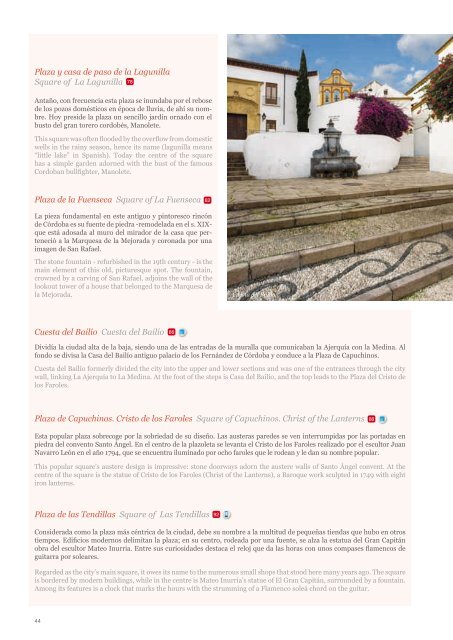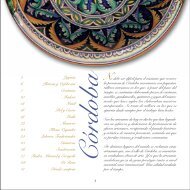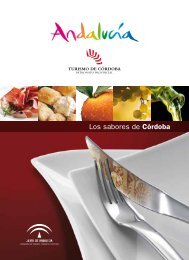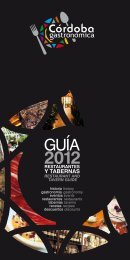You also want an ePaper? Increase the reach of your titles
YUMPU automatically turns print PDFs into web optimized ePapers that Google loves.
Plaza y casa de paso de la Lagunilla<br />
Square of La Lagunilla 78<br />
Antaño, con frecuencia esta plaza se inundaba por el rebose<br />
de los pozos domésticos en época de lluvia, de ahí su nombre.<br />
Hoy preside la plaza un sencillo jardín ornado con el<br />
busto del gran torero cordobés, Manolete.<br />
This square was often flooded by the overflow from domestic<br />
wells in the rainy season, hence its name (lagunilla means<br />
“little lake” in Spanish). Today the centre of the square<br />
has a simple garden adorned with the bust of the famous<br />
Cordoban bullfighter, Manolete.<br />
Plaza de la Fuenseca Square of La Fuenseca<br />
82<br />
La pieza fundamental en este antiguo y pintoresco rincón<br />
de Córdoba es su fuente de piedra -remodelada en el s. XIXque<br />
está adosada al muro del mirador de la casa que perteneció<br />
a la Marquesa de la Mejorada y coronada por una<br />
imagen de San Rafael.<br />
The stone fountain - refurbished in the 19th century - is the<br />
main element of this old, picturesque spot. The fountain,<br />
crowned by a carving of San Rafael, adjoins the wall of the<br />
lookout tower of a house that belonged to the Marquesa de<br />
la Mejorada.<br />
Cuesta del Bailío<br />
Cuesta del Bailío Cuesta del Bailío<br />
86<br />
Dividía la ciudad alta de la baja, siendo una de las entradas de la muralla que comunicaban la Ajerquía con la Medina. Al<br />
fondo se divisa la Casa del Bailío antiguo palacio de los Fernández de Córdoba y conduce a la Plaza de Capuchinos.<br />
Cuesta del Bailío formerly divided the city into the upper and lower sections and was one of the entrances through the city<br />
wall, linking La Ajerquía to La Medina. At the foot of the steps is Casa del Bailío, and the top leads to the Plaza del Cristo de<br />
los Faroles.<br />
Plaza de Capuchinos. Cristo de los Faroles Square of Capuchinos. Christ of the Lanterns<br />
88<br />
Esta popular plaza sobrecoge por la sobriedad de su diseño. Las austeras paredes se ven interrumpidas por las portadas en<br />
piedra del convento Santo Ángel. En el centro de la plazoleta se levanta el Cristo de los Faroles realizado por el escultor Juan<br />
Navarro León en el año 1794, que se encuentra iluminado por ocho faroles que le rodean y le dan su nombre popular.<br />
This popular square’s austere design is impressive: stone doorways adorn the austere walls of Santo Ángel convent. At the<br />
centre of the square is the statue of Cristo de los Faroles (Christ of the Lanterns), a Baroque work sculpted in 1749 with eight<br />
iron lanterns.<br />
Plaza de las Tendillas Square of Las Tendillas<br />
92<br />
Considerada como la plaza más céntrica de la ciudad, debe su nombre a la multitud de pequeñas tiendas que hubo en otros<br />
tiempos. Edificios modernos delimitan la plaza; en su centro, rodeada por una fuente, se alza la estatua del Gran Capitán<br />
obra del escultor Mateo Inurria. Entre sus curiosidades destaca el reloj que da las horas con unos compases flamencos de<br />
guitarra por soleares.<br />
Regarded as the city’s main square, it owes its name to the numerous small shops that stood here many years ago. The square<br />
is bordered by modern buildings, while in the centre is Mateo Inurria’s statue of El Gran Capitán, surrounded by a fountain.<br />
Among its features is a clock that marks the hours with the strumming of a Flamenco soleá chord on the guitar.<br />
44







